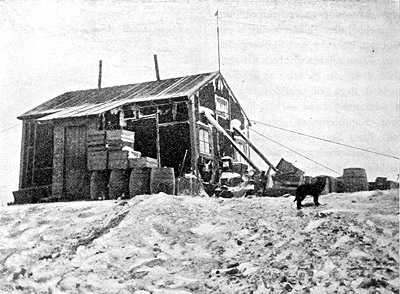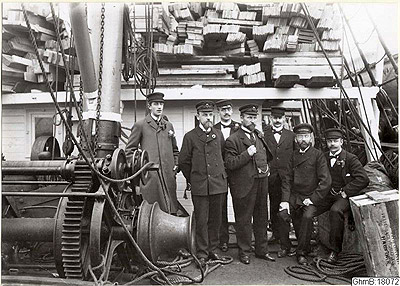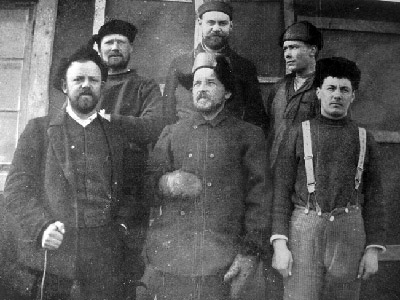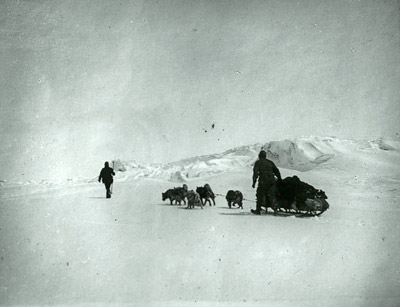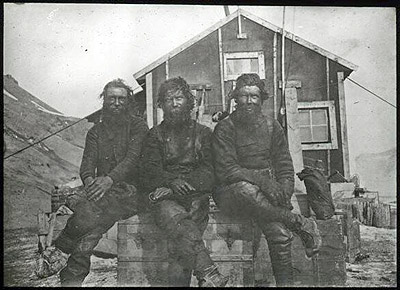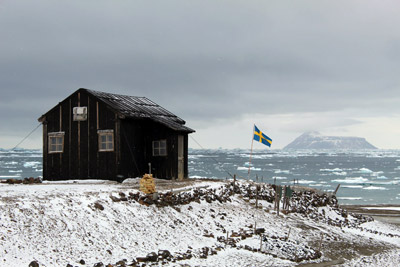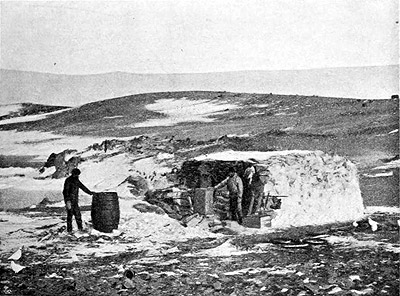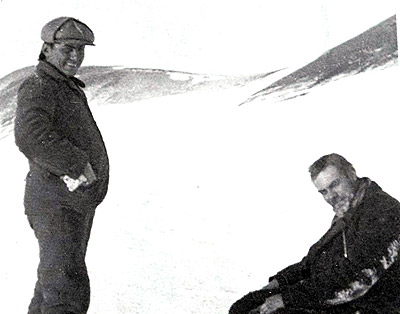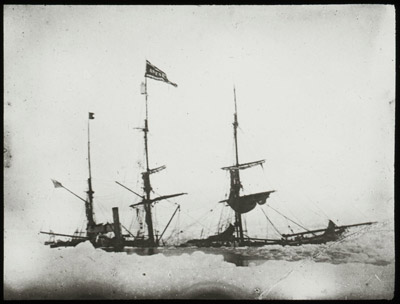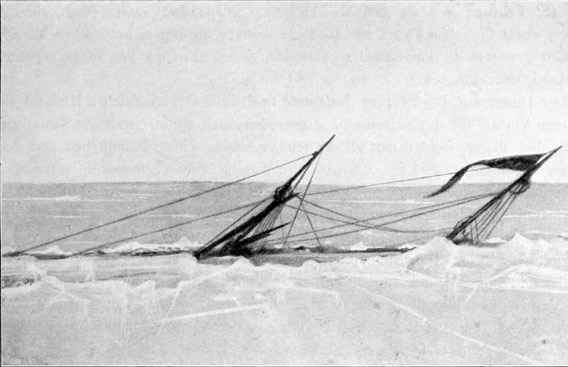Otto Nordenskjold - Antarctic (ship)
Swedish
Antarctic Expedition 1901 - 1904
time line and maps of the expedition
The Crew Alphabetically
Akerlundh, H - cook
Andersson, Axel - Cook
Andersson,
Johan Gunnar - Geologist
Andersson,
Karl Andreas. - Zoologist
Andreassen,
F. L. - First mate
Bjornerud,
Ole Johnsen - Smith
Bodman,
Gosta - Meteorologist and hydrographer
Duse, Samuel August - Lieutenant, Norwegian
artillery, cartographer
Duus,
Ole Peder - able seaman - joined at
Falkland Islands
Ekelof, Erik
- Medical officer and bacteriologist
Grunden, Toralf - able seaman
Haslum, H. J. - second mate
Holmberg, Wilhelm - fireman
Johansson, Carl - Fireman
Jonassen, Ole - engaged as an
experienced sledger
Karlsen,
Anders - First engineer
Karlsen,
George - Second engineer
Larsen,
Carl Anton - Captain of the "Antarctic"
Nordenskjold, N. Otto G. -
Expedition leader
Olaussen, Ole Martin - able seaman
Reinholdz, Axel R. - third mate
Schonbeck, G. F. - Steward
Skottsberg, Carl - Botanist
Sobral, Jose M. - sub-lieutenant,
assisted in various scientific work - joined at
Buenos Aires
Stokes, F. W. -
Artist - joined at Buenos Aires
Tofte
- able seaman, joined at Falkland Islands
Ula, Anton Olsen - Boatswain
Wennersgaard, Ole Christian - crew
member
Signed off in Buenos Aires: Aitken, John (Falkl.) able seaman, Jenner, Franck (British) able seaman
Two men were hired on 17 Dec. on the same day as Sobral and Stokes came aboard in Buenos Aires.
"A young man with a charming face and a carpenter (and
lazy)" in the captain's words. Jean and Harald Egelin,
lazy and disliked by all. Jon/Jan was dismissed from the crew
at Stanley Harbour on 14 July 1902.
diary of Captain
C. Larsen:
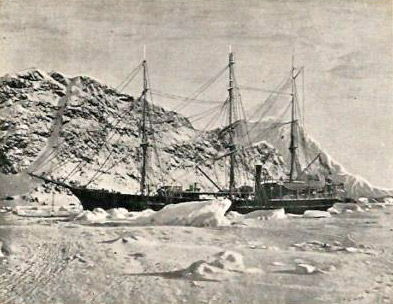
Early on in the Heroic Age as Robert Scott was planning his British Antarctic Expedition and Erich von Drygalski was planning his German National Antarctic Expedition, a Swedish geologist, Dr. Otto Nordenskjold was preparing to explore the Antarctic Peninsula region. The aim was to leave a small over-wintering party as far south as possible to be picked up the following season. The ship and non-wintering party planned to spend the Austral autumn and winter on scientific study in the Falkland Islands, South Georgia and Tierra del Fuego.
The expedition was not well funded being entirely dependent on private contributions unlike Scott's and Drygalski's expeditions that were government funded. The ship Antarctic left Goteburg on the 16th of October 1901 with a predominantly Norwegian crew and four Swedish scientists. En route south the ship called in at Falmouth England to take on coal. Nordenskjold travelled to London where he met William Spiers Bruce the leader of the Scottish National Antarctic Expedition that was shortly to leave. Nordenskjold and Bruce promised to rescue each other should it be required as they were to be within a few hundred miles of each other.
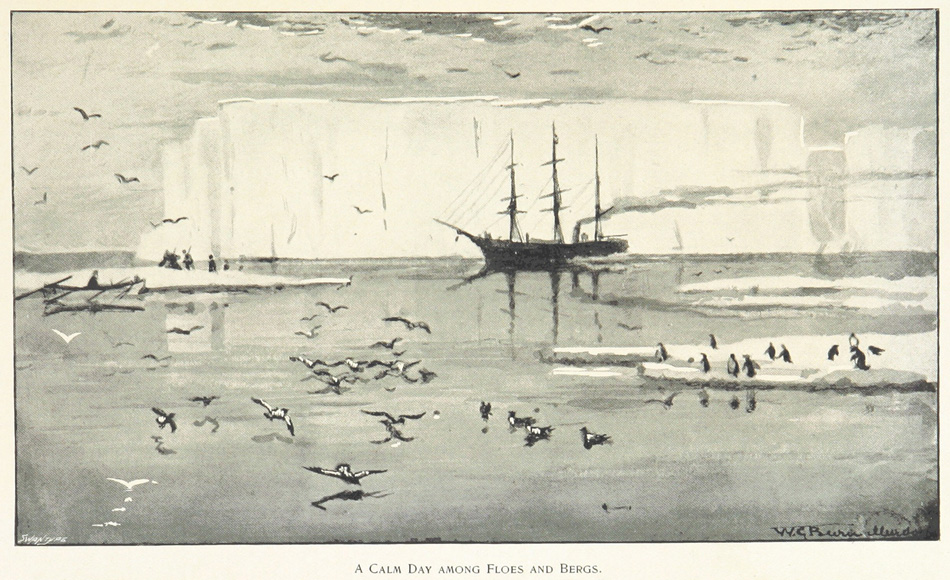 A Calm Day Among Ice Floes and Bergs
A Calm Day Among Ice Floes and Bergs
The ship went on to Buenos Aires, arriving on the 15th of December. Nordenskjold received an offer of food, fuel and help from the Argentinian government if the ship took an Argentinian naval officer Jose Sobral with them, he was also to be a part of the wintering party. They went on via the Falkland Islands sighting King George Island in the South Shetlands on the 10th of January 1902. After a short trip ashore at Nelson Island, they carried on south determining the lie of the land on the Western side of the Antarctic Peninsula, clarifying the presence of a strait rather than a bay which enabled them to keep on sailing south.
"We were now sailing a sea across which none had hitherto voyaged. The weather had changed as if by magic; it seemed as though the Antarctic world repented of the inhospitable way in which it had received us the previous day, or, maybe, it merely wished to entice us deeper into its interior in order the more surely to annihilate us. At all events, we pressed onward, seized by that almost feverish eagerness which can only be felt by an explorer who stands upon the threshold of the great unknown".
Nordenskjold's diary.
Time was pressing so despite wanting to continue further south, they turned around and began to sail north. They landed on Paulet Island to the Eastern side of the tip of the Antarctic Peninsula, made a depot of supplies on Seymour Island and proceeded south further down the Eastern side until they were stopped at 66°15'S by a band of ice. They attempted to sail east around it but with no end in sight and winter due to arrive soon, they turned back towards the Peninsula sighting land again on the 9th of February.
Over wintering at Snow Hill
Seymour Island was considered as an overwintering site, but nearby Snow Hill Island (frequently referred to simply as Snow Hill) slightly to the south west was chosen as it was low, easy to land on, had good rocky sites for building on and was surrounded by hills and ice walls that were presumed to provide some protection from the weather. Nordenskjold, Bodman, Sobral, Jonassen, Ekelof and Akerlundh were to spend the winter of 1902 here. Three days were spent bringing ashore equipment, supplies and sled dogs. There was a main hut and a smaller magnetic observatory, they also had two boats. The Antarctic then left, the autumn and winter being spent in scientific survey of South Georgia and Tierra del Fuego.
The winterers made trips by boat and sled with many lessons being learned the hard way. Not for the first time in Antarctic exploration, it became clear that the chosen base, in this case Snow Hill was a very exposed and storm-prone area with storms lasting for days at a time. Soon the magnetic hut was destroyed and several dogs died in the storms. In June one of the boats was blown away and wrecked. The men kept themselves busy with various scientific studies and while their living conditions were not ideal they were not not so bad, though they suffered the classic Antarctic blight of a significant temperature difference, 20 degrees in this case, from cold floor to ceiling where the warm air rose.
They became slowly grey as did everything in the hut covered in soot from the burning of coal and blubber to keep warm. They attempted longer journeys away from the hut to test out clothing and other equipment, on various outings the tent collapsed, dogs broke away and ran back to the hut or ate sledging food meant for the men. Undaunted they prepared equipment and sledging food once again to start later in the season when the weather was better. Three of the men managed a 33 day, 400 mile journey in October with 5 dogs, each of them losing about 5 pounds in the process despite being on full rations.
The winter passed and the winterers were looking forwards to the ice breaking up so that the Antarctic could come and take them home again. But by November the ice had not broken up, nor in December or January or even February, on the 18th of February a storm from the south froze the ice completely over sealing them in again for another winter. They had accepted their probable fate since January when nothing but close pack ice all round had been seen from a nearby hill. Four hundred penguins, thirty seals and skuas were taken for food and fuel for the forthcoming winter.
The second winter (1903) was passed with meteorological readings and some sledging journeys for variety. On the 12th of October, Nordenskjold and Jonassen on such a journey saw three men in the distance who turned out to be Andersson, Duse and Grunden from their ship the Antarctic, though black with soot and unrecognisable, the meeting point was thus named Cape Well-met.
Over wintering at Hope Bay
The Antarctic had set out to relieve the Snow Hill overwintering party the previous November (1902) though was unable to get through the Antarctic Sound because of sea ice, they had sent two men to climb a peak to see to the east which revealed a continuous ice sheet. On the 29th of December 1902, Andersson, Duse and Grunden had been put ashore at Hope Bay to fetch the overwintering party to the ship, a distance of 200 miles. They made good progress at first but then met with open water blocking their path, so they returned to await the ship back at Hope Bay, Andersson collected fossils of ferns and other plants which provided evidence that the Peninsula had not always been frigid and virtually devoid of plant life.
In the absence of the ship, after a month the three built a small hut with a nearby tent as sleeping quarters, they killed and cached several hundred penguins for food and fuel for the winter (1903) which was passed in discomfort and deprivation of food and fuel in both quantity and variety. Time lay particularly heavily on them, they had little to occupy themselves with and no work to do, they were intended originally to simply to carry a message and then return with the Snow Hill party. With the arrival of spring, the three knew that if the Antarctic had been lost, no-one would know they were there and so they set out for Snow Hill on the 29th of September, meeting Nordenskjold and Jonassen at Cape Well-met two weeks later. The five then returned to Snow Hill where a celebration as close to a banquet as could be managed under the circumstances was held.
Rescue
On the 8th of November 1903, there were seven men in the Snow Hill hut with two away, in the distance four figures could be seen approaching from the direction of Seymour Island, the extra men turned out to be two Argentinian naval officers from the ship Uruguay who had set off on a pre-arranged rescue mission at the end of the winter when the Antarctic had failed to return to South America for the austral winter. It was now assumed likely that the Antarctic and it's crew were lost.
At around 10.30pm the same day the dogs began to bark, six people were approaching the hut they were Captain Larsen of the Antarctic and five others from the crew. Nordenskjold was overjoyed, they had just begun to resign themselves to the loss of the ship and all hands, when here were men from that very ship who told that all were well other than one young seaman who had died during the enforced winter. The whole group left the Snow Hill hut and crossed the sea-ice to the Uruguay, scientific specimens were collected from depots where they had been left and the ship went to rescue the remaining Antarctic crew from Paulet Island where they had wintered.
The fate of the ship Antarctic
After dropping off the Hope Bay party in December 1902, the Antarctic had been squeezed by the pressure of the surrounding ice and the planks began to leak. At first the leaking water was pumped out, but slowly the ice began to win, the pump could not cope, leaks could not repaired, the keel was damaged and planks were lost. Paulet Island was 25 miles away across rough and broken sea ice with wide leads of open water, with the situation hopeless, the ship was abandoned, the crew watched as it was crushed and sunk beneath the ice carrying most of their world with it.
They struggled across the ice to land with what they could drag, the ships' whale boats, more than a ton of food, 240 litres of petrol and the ships' cat amongst other essentials. Fortunately the drift of the sea-ice was with them, they reached Paulet Island on the 28th of February 1903, knowing that no-one knew their whereabouts, they would have to survive the winter and try to reach help in the spring.
Over wintering on Paulet Island
On Paulet Island the now stranded crew of the Antarctic secured 1100 penguins for winter food and fuel and built a 34 by 22 feet hut from flat stones found around. The hut was barely high enough to stand erect in the middle and required stooping to enter, two stone beds 7 feet long and twenty feet wide slept ten men each. They lived on penguins occasionally supplemented by fish, tainted yellow-green water came from a lake below the penguin colony. Their footwear had not been intended for an Antarctic winter though their clothing along with the shelter was enough for survival. Like the three men wintering at Hope Bay, one of their biggest challenges was how to pass the time, "One grows stupid lying in the bags all day".
The atmosphere in the hut was dirty with soot from burning blubber, the smell of which added to the stench from decaying penguin skins used to try and soften the stone beds and provide some insulation. A young sailor Ole Wennersgaard fell ill, grew worse and died in June, his body was placed in a snow drift until he could be buried properly in the spring.
At the end of October with the break up of the sea-ice, a whaleboat was launched by Larsen and his five companions heading to Hope Bay arriving on the 4th of November, 5 weeks after the three men who had wintered there had left. They found a map in the hut and taking a the tarpaulin from the hut roof to shelter under and a tent pole for a mast launched the whale boat again to head for Snow Hill. Stopped some 12-15 miles away by sea-ice they covered the remaining distance on foot on a seven hour march. Larsen and his companions were overjoyed to find not only the men from the Snow Hill and Hope Bay parties alive and well, but the presence of an Argentinian rescue ship.
The fourteen men who remained at Paulet Island, unsure of their fate and now surrounded by breeding penguins gathered 6,000 eggs. On the 11th of November, 11 days after Larsen had set off in the whaler, the Uruguay arrived in the night to an ecstatic reception by the remaining men.
They left Antarctica for Buenos Aires where the crew transferred to a steamer for Stockholm.
The expedition scientists had gathered much valuable scientific information despite their difficulties and published reports that set the standard for subsequent expeditions. The expedition had also made significant contributions to exploring the geography of the Antarctic Peninsula. These things were accomplished while overcoming formidable obstacles requiring courage and tenacity by all to survive the events of the expedition.
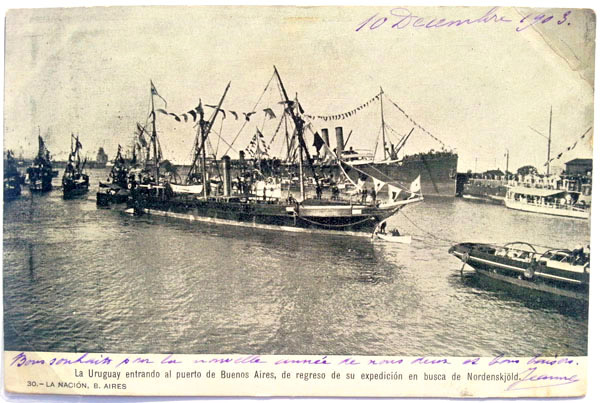
The Uruguay arriving in Buenos Aires
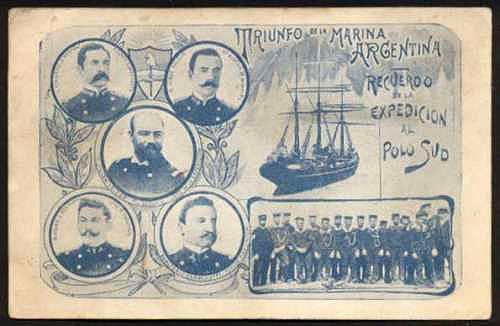
Postcard of the officers and crew of the Uruguay

